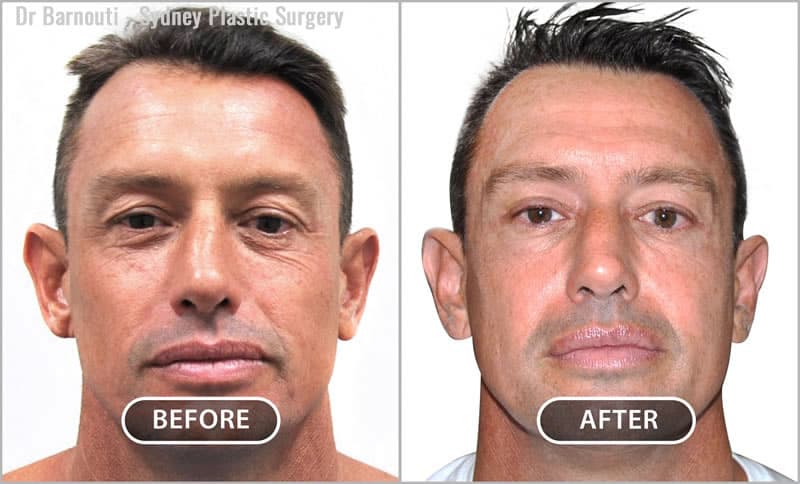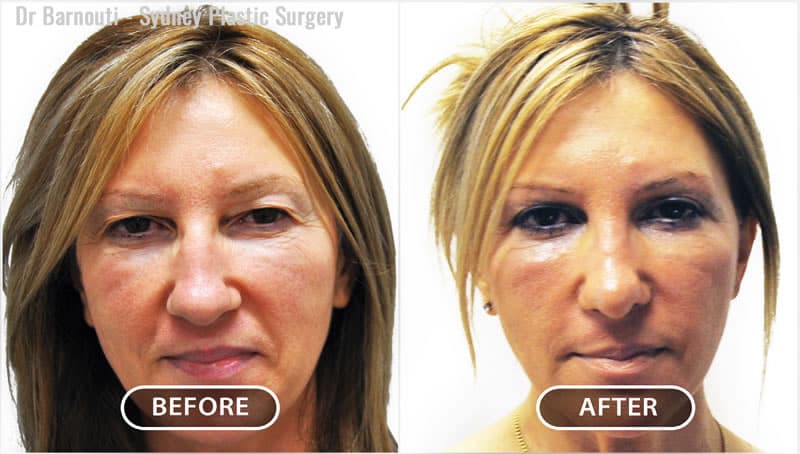This blog post is an excerpt from Dr Barnouti’s book “Your Guide To Modern Plastic Surgery: How To Enhance Your Natural Beauty And Avoid A Plastic Surgery Disaster” which is available now on Amazon.
Upper eyelid surgery performed with laser rejuvenation. Notice the improvement in the skin quality of the lower eyelids without direct surgery to the lower eyelids.
Close attention needs to be paid to the pre-operative condition of the eyelids, surrounding tissue and bone structure to create a natural appearance and prevent an “operated-on look”. Removal of excess skin and fatty tissue will tighten the eyelids and restore shape to the eyes while meticulous attention to surgical detail can avoid a “hollowed” appearance or unwanted complications.
Ancillary procedures can be performed at the same time as eyelid surgery to optimise the outcome. These include: laser, fat injection, a brow lift and/or facelift. In a typical eyelid plastic surgery procedure, an incision is made in the natural line of the upper eyelids, normally in the creases of the upper eyelids.
Incisions for lower eyelid surgery are made just below the eyelashes or inside the conjunctiva, which is the inner surface of the eyelid. Working through these incisions, the skin is separated from the underlying fatty tissue and muscle. The excess fat bulges are then removed and transposed (rearranged). If required, I trim away any sagging skin and muscle. The incisions are then closed with very fine sutures, and the final scar is virtually undetectable six weeks after surgery.
Upper Eyelid Surgery
Upper eyelid surgery to remove excess upper eyelid skin is a delicate operation. During this 60-minute procedure, the excess skin is trimmed, the saggy portion of the muscle is excised or tightened and the fat bulges removed. Sutures are removed after seven days.
When I perform upper eyelid surgery, I create a tunnel to the lower eyelids in the most lateral part of my incision. This reduces the risk of pre-septal haematoma. A small amount of blood trickles into the lower eyelids, producing a PRP effect. Notice the slight improvement in the lower eyelids, even though I have not operated on the lower eyelids.
This is the result of upper eyelid surgery. Notice the slight improvement to the lower eyelids even though I have not operated on the lower eyelids. A plasma rich protein effect through a lateral tunnel.
Lower Eyelid Surgery
Different types of incision are made with lower eyelid surgery. The most common is the subcilliary, in which the incision is made just underneath the line of the lash. This approach is used when the skin is loose and requires removal in addition to the removal of the bulging fat pads.
If there’s a pocket of fat underneath the lower eyelids, but there is no loose skin to be removed, then the preferable approach is a transconjunctival one where an incision is made on the inside of the lower eyelid with no external scar. This approach is often used in conjunction with laser treatment to rejuvenate the lower eyelid skin.
The objective of this delicate surgery is to smooth out the bulges, remove the bags from underneath the eyes and make the skin snugger.
Removal and redrapping of lower eyelid fat bags through an internal transconjunctival incision. The key point is to avoid excess fat removal as it will produce hallowing.
Lazy Eyelid Surgery
Some people are born with lazy eyelids and some develop the condition later in life. The reason for a droopy eyelid is a functional weakness of the eyelid-opening mechanism, called the levator. Lazy eyelid surgery, sometimes called ptosis correction surgery, corrects these droopy eyes by tightening the levator muscle.
Find out more about our Eyelid Surgery procedures at Sydney Plastic Surgery >>










